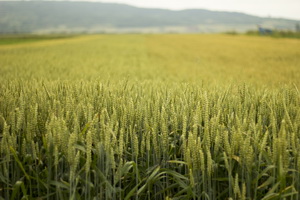
Study Shows How Plants Use 'Baits' to Trap Pathogens
February 28, 2018| |
 A study published in Genome Biology shows how plants use ‘baits' to recognize and trap disease-causing pathogens before infection can start.
A study published in Genome Biology shows how plants use ‘baits' to recognize and trap disease-causing pathogens before infection can start.
Ksenia Krasileva and her team from Earlham Institute, together with researchers from The Sainsbury Laboratory, used phylogenetic analyses to identify how these ‘bait' genes are distributed throughout different wild and domestic grasses, including crop plants such as wheat, barley, maize, and rice. Their findings could be vital in engineering crops to be resistant to emerging diseases caused by pathogens.
By studying the genetic history of the plants, the researchers found several interesting groups that lean towards forming novel linkage with plant receptors, which were most diverse in wheat. These proteins are involved in plant stress responses in general, specifically in defense against pathogen attack. Furthermore, specific plant pathogen receptors known as nucleotide binding leucine rich repeat (NLR) proteins exhibited the ability to recognize some of the signals linked to disease-causing agents. By getting portions of proteins coded by other genes, which are often the target of pathogen infection, NLRs act as an ‘integrated defense decoy'.
Pathogens that are harmful to plants are continually evolving, thus, the researchers are hoping to develop new proteins with specifically integrated domains that give resistance to plant pathogens, particularly new threats to the important crops.
For more information, read the news release from Earlham Institute and the research article in Genome Biology.
| |
Biotech Updates is a weekly newsletter of ISAAA, a not-for-profit organization. It is distributed for free to over 22,000 subscribers worldwide to inform them about the key developments in biosciences, especially in biotechnology. Your support will help us in our mission to feed the world with knowledge. You can help by donating as little as $10.
-
See more articles:
-
News from Around the World
- WEMA Gives Hope for Farmers Battling Armyworm in Kenya
- Ghana CSIR Affirms Safety of GM Crops
- Research Reveals New Approach to Improve Nitrogen Use, Enhance Yield, and Promote Flowering in Rice
- Researchers Monitor Photosynthesis in Soybean Using Invisible Light
- Scientists Discover Secret of How to Triple Number of Sorghum Grains
- India Launches Massive Pink Bollworm Awareness Campaign
- Increasing Sugar Yield and Biomass Production in Arabidopsis Discovered by VIB Scientists
- Land Plants Evolved 100 Million Years Earlier than Thought
- Study Shows How Plants Use 'Baits' to Trap Pathogens
-
Research Highlights
- RNAi-mediated Knockdown of GmFAD2-1B Improves Oil Quality in Soybean
- Rice Gene Confers Citrus Canker Resistance to Transgenic Mandarin
-
Beyond Crop Biotech
- Researchers Unlock Genetic Code of the Brightest and Most Vibrant Colors in Nature
-
Announcements
- BIO Asia International Conference
-
Resources
- Plants, Genes, and Agriculture Book
-
Plant
- CRISPR-Cas9 Used in Reverse Genetics Studies of Parasponia
- lncRNA1459 Knock-out Alters Tomato Fruit Ripening
- Researchers Apply CRISPR-Cas9 on Cacao Leaves
- Transgenerational CRISPR-Cas9 Induces Multiplex Gene Editing in Wheat
-
Read the latest: - Biotech Updates (December 17, 2025)
- Gene Editing Supplement (December 17, 2025)
- Gene Drive Supplement (February 22, 2023)
-
Subscribe to BU: - Share
- Tweet
